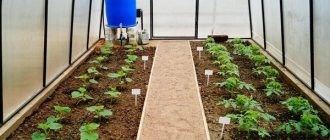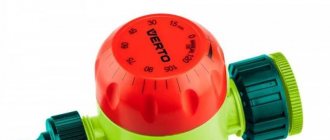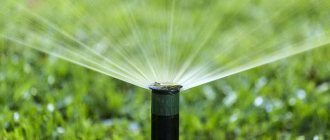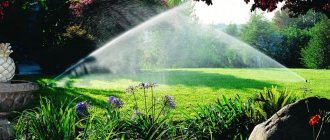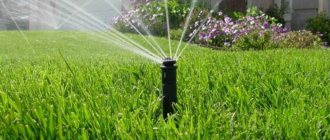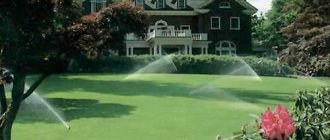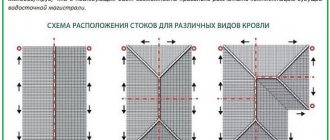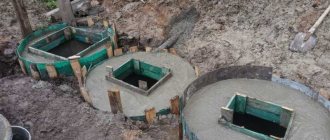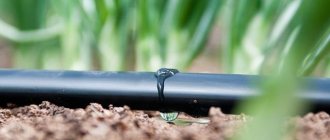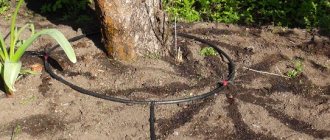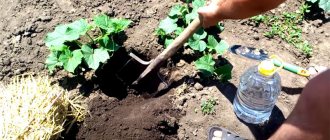Advantages of the drip irrigation method
The drip tape irrigation method has been used for many years. It has a lot of advantages compared to other methods of watering the garden, in particular the following:
- resources are saved significantly;
- increasing productivity;
- reducing the spread of weeds;
- reduction of plant diseases;
- beds and plants are not damaged.
Thus, drip tape provides soft and safe watering of your garden crops.
Tape design
The design of the drip irrigation tape is very simple - it is a thin-walled tube with holes . Options for outlets may be different, and the durability of the entire system and the quality of irrigation will depend on this. The main feature of this type of irrigation is that it can be used for any crops, shrubs, fruit trees, vegetable beds, flower beds, etc.
How to create and use drip irrigation at your dacha with your own hands
This system consists of a drip tape and a simple hose to which the droppers are connected. Types of drip irrigation are presented in two versions. The first implies the presence of miniature built-in droppers in the hose. The other is a large set of drippers that connect to a pipe.
Before water enters the irrigation system structure, it passes through a filter . Due to this, the structure does not become dirty and its service life is extended. Passing through a large number of cleaning holes, which are located in the regulating channel of the tape, the water passes into the labyrinth channel, where its flow is regulated. The liquid then passes into the outlets. The root system of plants is irrigated, which ensures more complete development of garden crops. Often, a drip system is used to apply fertilizers.
Types of drip tapes
for irrigation :
- The labyrinth type design is the simplest option. On the surface of its pipe there is a special channel in the shape of a labyrinth. Such a labyrinth reduces the water pressure during irrigation, and the water seeps out by drip. However, its disadvantages are fragility, poor strength and uneven irrigation. Also, during the construction of the system, a lot of effort must be made to ensure that the holes for watering the garden are at the top;
- slotted - it will be more reliable than the first one. It also has a water channel in the form of a labyrinth, but it is located inside the tape and not outside. Thanks to this, it will be easier to install the system, and there will be less risk of damaging it. In both cases, the cleanest possible water should be used for irrigation. Even if you use a powerful dirty water filtration system, it will become clogged very quickly and the very next year you will have to completely change the lines for watering your garden;
- Emitter drip tape is the most modern solution. Irrigation is carried out through emitters - flat droppers in the form of labyrinths. This design creates turbulent flows that purify the water. It clogs less and can last up to three seasons.
Water consumption by drip tape emitter
The choice of water flow rate for the emitter in the drip tape depends on the quality of the water, the capabilities of the water source, the length of the drip tape line, the water needs of the crop, the method of planting and the ability of the soil to absorb water.
For example. Choosing a drip tape with low-flow emitters ensures minimal friction loss while allowing long drip rows to be laid and providing better water distribution. At the same time, low water consumption by the emitter requires a higher level of filtration and a long operating time of the irrigation system.
Emitter with flow rate 2.0 – 3.8 l/h
An emitter with increased water flow, often used in a two-row planting pattern for crops with developed root systems that require a lot of water in sandy soils with rapid absorption. Large channels of such emitters are more difficult to clog.
Emitter with flow rate 1.0 – 1.5 l/h
Standard flow, recommended for most crops and soil types.
Emitter with flow rate 0.6 – 0.8 l/h*
Economical water flow for very long irrigation lines for low yield water sources for soils with low watering rates. Requires a high degree of filtration.
Low flow emitters require the use of a very high degree of filtration and water purification.
Drip tape for watering double-row planting of onions
Areas of application for drip tapes
Drip irrigation tapes have different emitter pitches ; the smaller it is, the more expensive it will be. However, when purchasing drip tapes, you need to focus not only on the price, but also on the crops that will be watered:
- products with an emitter pitch of 10 cm are used for watering those plants that are planted at a short distance from each other, such as onions, carrots or lettuce; they are also suitable for watering sandy soils and moisture-loving plants;
- drip tapes in increments of 20 cm are appropriate for watering cucumbers;
- designs with a pitch of 30 cm are designed for irrigating medium-grained soils and plants that are planted at an average distance from each other, such as eggplant or tomatoes;
- if it has a pitch of 40 cm or more, then it is suitable for watering plants that are planted at the maximum distance from each other (pumpkin, melon, zucchini), potatoes and for long irrigation lines.
What is drip tape and how to choose drip tape?
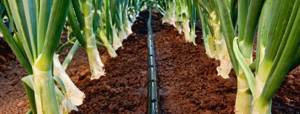
DRIP IRRIGATION – WHAT IS IT?
The most effective system for moistening the soil is drip irrigation. Drip irrigation is used in plant growing, horticulture, viticulture and is used both in open and closed ground (that is, in greenhouses).
Today, the automated drip irrigation system is used thousands of kilometers not only in Ukraine, but also abroad. And every day more and more consumers (not only farms, but also summer residents) are switching to “drip”, because they know that investments in this type of irrigation pay off faster than any other type of irrigation.
To organize automatic watering, drip tape and fittings are used. And if everything is more or less simple with fittings, then you should approach the choice of drip tape carefully and responsibly, since many manufacturers produce a large number of its varieties, which have different characteristics. Therefore, in this article we will talk to you about how to choose and which drip tape is best to buy? But let's first figure out what drip tape is and what types of tape it comes in?
TYPES OF DRIP TAPE
Drip tape is a thin-walled polyethylene tube into which droppers (slits, emitters) are inserted at a certain pitch (10 cm, 20 cm or 30 cm) and in a special way, from which water under pressure is poured under the root of the plant at a certain flow rate, for example, 0 .8 l/h, 1 l/h, 1.6 l/h.
Drip tape is suitable for all types of plants (strawberries, blueberries, raspberries, grapes, tomatoes, peppers, cucumbers, cabbage, potatoes and other crops, as well as flowers, fruit tree seedlings) and is used for installation on any site, regardless of its landscape features.
There are several modern types of drip irrigation tape based on the method of making holes in it:
- slotted;
- emitter;
- labyrinthine.
The most popular are the first two types of drip tape - slot and emitter. These are the ones we will consider.
The slotted drip tape is structurally a polyethylene tube, in certain places of which special slotted holes are made with the help of a laser, through which the liquid seeps out. Inside, the tape along its entire length has a flexible labyrinth, which slows down the rate of water supply and makes irrigation more uniform.
This type of automatic watering system is quite simple to install and reliable to use. However, there is no thorough filtration, which is why the narrow slots become clogged after a while. Therefore, when using a slotted drip tape irrigation system, it is very important to carefully monitor the purity of the water. To ensure good water filtration, it is recommended to additionally install special accessories for drip irrigation, namely a filter for drip tape.
The emitter drip tape has flat droppers (emitters) built in along its entire length at equal distances, the jet pressure inside of which is regulated by a special labyrinth. The labyrinth creates a turbulent water flow, due to which it self-cleanses itself from various impurities, avoiding clogging of droppers and the formation of plaque.
Emitter tape for drip irrigation can be compensated or uncompensated. For an uncompensated emitter tape, in contrast to a compensated one, the water flow rate of the droppers is more dependent on the slope of the area and the length of the drip line, and this must be taken into account when designing the irrigation system. You should also take into account the fact that an uncompensated emitter tape, which is used in most cases, costs less than a compensated one. Well, if you compare the cost of slotted and emitter drip tapes, the first one will cost less, but you will have to additionally purchase filters for it. So, it is not a fact that you will be able to save significantly when purchasing slotted drip tape.
HOW TO CHOOSE DRIP TAPE?
When choosing a tape for drip irrigation, you need to pay attention to such technical parameters as the diameter and thickness of the tape, the pitch of the emitters and their water consumption, as well as the permissible operating pressure.
► Diameter of drip tape
Drip tape is available in two diameters: 16 mm and 22 mm. As a rule, 16mm tape is most often used.
► Thickness of drip tape
• 5 mils (0.125 mm) – recommended for annual plants with a short ripening period, as well as for soil with a minimum content of stones, suitable for indoor use;
• 6 mils (0.15 mm) – suitable for growing plants with a long ripening period;
• 8 mils (0.2 mm) – used for growing plants with a long ripening period, can be reused if handled with care, washed and dried at the end of the season;
• 10 mils (0.25 mm) – designed for use in rocky soil with increased exposure to insects and animals;
• 12 mils (0.3 mm) - thick-walled drip tape for use in rocky soils with increased exposure to insects and animals;
• 15 mils (0.375 mm) – designed for use on very rocky soil and in conditions of increased mechanical damage to the belt.
The thickness of the drip tape only affects its strength; therefore, this parameter determines how long the tape will function in field conditions when exposed to various mechanical factors.
It should be noted that the most popular among users and the most versatile in use is drip tape with a thickness of 6 mils and 8 mils.
► Distance between outlets (“droppers”)
The choice of the distance between the outlets in the drip tape is based primarily on the distance at which the plants are planted from each other. Also, the choice of pitch of the “droppers” can be influenced by the planting method: single-row or double-row.
Emitter pitches 10 cm, 15 cm, 20 cm are used:
– for crops planted close to each other (for example, onions, garlic, lettuce, raspberries);
– on sandy soils with rapid absorption;
– if high specific water consumption per meter is necessary;
– when irrigation of plants with a continuous line is required.
Emitter pitch 30 cm is used:
– with an average distance between plants (for example, strawberries, peppers, cucumbers, potatoes);
– on medium-grained soils.
Emitter pitch 40 cm is used:
– with a large distance between planted crops (for example, tomatoes, pumpkins, zucchini, watermelons);
– if it is necessary to create long irrigation lines.
► Water consumption “dripper”
The choice of water flow rate for a drip tape emitter depends on the capabilities of the water source, the length of the watering line, the crop's water needs, how the plant is planted, and the ability of the soil to absorb moisture.
An emitter with a flow rate of 2.0-3.8 l/h is used in a two-row planting pattern for crops with a developed root system that require a lot of water in sandy soils with rapid absorption.
An emitter with a flow rate of 1.0-1.5 l/h is the most popular, as it is recommended for most crops and soil types.
An emitter with a flow rate of 0.6-0.8 l/h is recommended for very long irrigation lines, for water sources with low productivity, for soils with low wetting rates. A “dropper” with low water flow provides minimal friction losses, but requires a high degree of filtration and water purification.
► Operating pressure of drip tape
When choosing a tape for irrigating beds, do not forget that the drip tape is a thin-walled tube that can withstand pressure no more than the value indicated by the manufacturer on the packaging. Otherwise, the drip tape will simply break.
In addition to the maximum permissible, it is also necessary to take into account the minimum operating pressure at which the emitter begins to release water, since if the pressure is too low, the amount of water from the “dropper” can decrease up to 3 times from the rated value.
If there is a source with high pressure for water supply, then to lower it to the operating range of the drip tape, a special element is used - a water pressure reducer.
As you can see, to create the most effective micro-irrigation, you need to choose a drip tape with the most suitable characteristics. And for the device to be durable, we must give preference to products from reliable manufacturers who use modern equipment for the production of drip irrigation tape and use the highest quality raw materials. Therefore, we recommend that you pay attention to the Israeli drip tape NETAFIM (NETAFIM), and from domestic ones we recommend the drip tape AquaPlus (Aqua Plus).
WHERE TO BUY DRIP TAPE?
You can buy drip tape wholesale and retail in our online store agrovinn.com. Our assortment includes emitter and slot drip tape, both Ukrainian and European production.
You can pick up the drip irrigation tape purchased from us yourself from the AGROVINN warehouse in Vinnitsa, or we can deliver the goods by Nova Poshta or InTime services to Kiev, Odessa, Nikolaev, Summy, Kherson, Kirovograd, Cherkassy, Poltava, Zaporozhye, Kharkov, Dnepropetrovsk, Ternopil, Khmelnitsky, Zhitomir, Chernivtsi, Lviv, Uzhgorod, Ivano-Frankivsk, Lutsk or any other locality in Ukraine.
Contact us! We will be happy to take care of your future harvest!
How much water is needed for drip irrigation?
Remember that when using an emitter-type drip design, you can save water consumption. At the same time, you need to use water wisely, because all plants need watering differently, but the irrigation system and soil require a certain amount of water.
The consumption is approximately this:
Recent Entries
Chainsaw or electric saw - what to choose for the garden? 4 mistakes when growing tomatoes in pots that almost all housewives make Secrets of growing seedlings from the Japanese, who are very sensitive to the soil
- from 2 to almost 4 liters per hour for sandy soil, two-row plantings and crops with a strong root system;
- up to one and a half liters - the best option for most gardens;
- less than a liter per hour is sufficient for long watering systems, dense clay soils, or when it is impossible to provide sufficient pressure when watering.
The drip tape contains instructions that indicate what emitter water flow it provides. Also, when drip irrigation, mulching of the soil should be taken into account, since moist soil significantly increases thermal conductivity.
Individual watering needs
The moisture needs of plants depend primarily on the type of crop being grown and weather conditions. These include:
- temperature in the greenhouse;
- air humidity;
- intensity of sunlight or artificial lighting.
On open ground, slope exposure, wind strength and soil composition also play a role. Therefore, calculation of consumption in each specific case must be carried out individually.
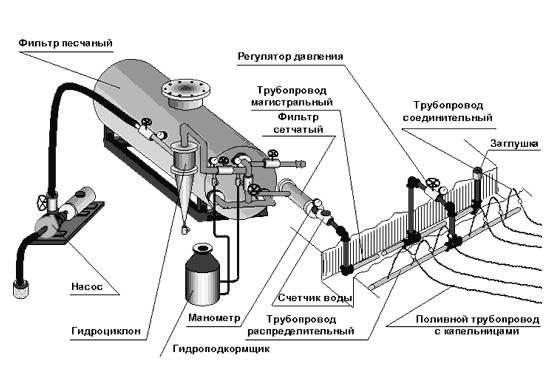
Drip irrigation system.
To calculate the irrigation rate, you can use the Pennman equation or measure soil moisture using tensiometers or potentiometers. In large greenhouse farms, special equipment is used to control the supply of moisture to plants, analyzing daily fluctuations in the dynamics of fruit growth and stem diameter.
But no matter what method or combination of methods is used, no expert can predict the water consumption during irrigation in advance.
The basic water requirements of each vegetable crop are clearly stated in special reference books. But to calculate moisture consumption, it is necessary to know the indicators of the lowest moisture capacity for a specific soil. Because for different soil compositions these figures may differ by 1.5-2 times. Moisture capacity can only be determined using special laboratory analysis.
Drip tape parameters
When purchasing drip tape, you should also pay attention to its thickness and diameter. The optimal thickness is from 0.125 to 0.375 mm and affects the strength of the tape.
The lower this value, the thinner the material. When handling it, you must be careful and avoid mechanical impacts on the tape. Thick ribbons can be used for watering rocky surfaces and will also serve as protection against insects. In addition, they can be used for more than one season. But the diameter of the drip tape affects the length of the irrigation line. In drip irrigation systems, water consumption depends directly on the length of the tape and the slope of the soil surface.
Most often, the tapes have a diameter of 22 and 16 mm. In addition, drip tapes can have varying degrees of protection against blockages, and to obtain clean water, filters with varying degrees of water purification are used. The average cost of drip tape is about 8 rubles per meter.
Why do you need drip irrigation tape?
VladimirForumHouse Member
The snow has melted, the ground has dried up, there is no rain. Last year, to water everything we needed, we carried a total of a ton of water a day in watering cans. It’s like that again – thank you! Drip irrigation foreva!
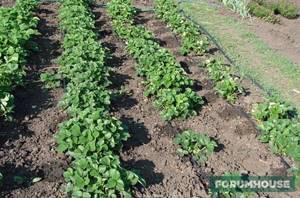
Any owner of a country plot, especially a FORUMHOUSE user, always has a great temptation to make some kind of garden device himself, from available materials. The drip irrigation system is no exception; it seems that the drip tape in it can easily be replaced with a HDPE pipe. FORUMHOUSE SirEZ participant developed the following design: HDPE pipe 20, holes 2-3 mm every 20-30 cm.
SirEZ
The pipe is laid directly on or next to the seedlings; I hill up the potatoes and the pipe is filled up. The pressure in the system is from 1 to 2.5 meters of the water surface level.
At FORUMHOUSE our user was immediately told that such a system would not work. The main part will go through the holes at the beginning of the pipe, but it may not reach the holes at the end of the pipe.
gen758 Member FORUMHOUSE
Buy a drip tape and create a pressure of 1-1.4 atm!
The drip irrigation tape allows you to bring water to each plant, regardless of the landscape of the site, and allows you to accurately dose its amount, delivering moisture directly to the root of the plant.
Installation of a drip irrigation system
The simplest drip irrigation system is a gravity flow system , which you can assemble with your own hands like this:
- When assembling the structure of this system, metal parts cannot be used so that slow corrosion does not aggravate the risk of blockages;
- place a container with liquid on a raised surface;
- every meter of height at which it is installed increases the system pressure by 0.1 bar;
- Make a cut above the bottom so that a lot of debris does not get into the system, and install a tap;
- attach a filter to the faucet;
- attach a pipe that should be perpendicular to the ground;
- opposite each of the beds, drill holes in the pipe for smart connectors;
- install a tap at the end of the pipe to flush the system;
- install all smart connectors;
- Carefully lay the tape along the bed with the emitters facing up. If the plants grow in one row, then the tape should be laid on the side, and if in two, then the tape should be placed between the rows;
- On one side, the drip tape needs to be connected to the smart connector, and on the other side, plugged.
Homemade drip irrigation device
If it is not possible or desirable to purchase industrial kits, then you can assemble the system yourself. First you need to decide what you need for drip irrigation on your site, and then start assembling. Of course, it is necessary to have a source of water on the site. This could be a water supply, a well or a container of water. Next, you need a distribution tube, which can be used as a regular garden hose. It is imperative to install a water purification filter, otherwise after a short time you will have to change all the hoses due to their contamination. You will also need drip tapes and droppers that supply water directly to the plants and various adapters.
An important factor is the water pressure in drip irrigation, because the result completely depends on this. Industrially produced systems are capable of withstanding a pressure of 2 atm and no more, so it is advisable to install a reducer on the site - a water pressure regulator. When the pressure increases, water can flow at the joints, and when the pressure decreases, the flow of water will be uneven. To create the required level of pressure, it is necessary that the container with water is at a height of 1.5-2 meters above the object being watered.
What is needed to connect the system?
Before assembling the drip system, it is advisable to draw up a plan according to which the pipes will be laid out on the site, and decide what connecting elements are needed for drip irrigation and how many. The structure is connected using fittings - the main pipes are connected to the water supply system using splitters, and the pipes are connected to each other by tees.
In drip tapes and tubes connected through adapters to tees, holes are made for branching into which rubber seals and splitters are inserted. The dripper hoses are connected to the branches and stuck into the ground, in close proximity to the plants.
System connection diagram
Organization of drip irrigation in a greenhouse
If you wish, there is nothing difficult in setting up homemade drip irrigation in a greenhouse with your own hands, which will greatly facilitate the care of greenhouse plants. One option is to use drippers, which may differ in their functionality: with some it is impossible to regulate the water flow, while others can pass the required amount (from 2 to 20 l/hour), depending on the needs of the crops being grown. You will also need water supply hoses, which need to be connected to the main pipe.
For small private greenhouses, the option with drip tapes is more suitable, which is affordable for any gardener. Such a system can be assembled from a regular plumbing hose, various fasteners and drip tape (a thin-walled polyethylene tube with holes). One end of the tape is connected to the leading pipe, and the other is closed with a plug. You can make as many branches from such a tape as there are beds in the greenhouse. One such tape will replace droppers, tubes, and various fittings. A significant disadvantage of drip tapes is their short service life.
Drip irrigation of strawberries
When growing berry crops on a plot, it is not very difficult to organize drip irrigation of strawberries from a well located on the plot. To do this, it is enough to use a pump, a control unit, hoses and droppers and a large container for water (for example, a barrel). Two hoses are connected to the container - one goes into the well, and the other goes to the strawberry bushes. It is advisable to connect an automatic system that controls the frequency of watering. Bushes that are watered using this system are significantly superior in yield and leaf growth to crops that are watered in the usual way.
Irrigation systems using improvised means
The simplest system can be organized from simple available means, for example, you can consider how to make drip irrigation from Tetropack so that the plant gradually receives the required amount of water. To do this, you need to make a certain number of small holes in the Tetropack package, pour water into it and place it with the hole facing the ground next to the root system of the plant. Gradually flowing out of the bag, the water will moisten the soil. All that remains is to periodically fill the packaging with water.
Raised beds
If you need to set up drip irrigation on high beds on your site with your own hands, you will need the same equipment as for watering ordinary beds. These are drip tapes or hoses, main pipes, fittings for connections and a water container equipped with a tap and filter and installed above the beds. Instead of a container, you can use a water tap directly, but then it is better to install a reducer.
DIY making
The cost of drip irrigation will depend on the type of design. This system is quite affordable, but some gardeners, in order to save money, make this design with their own hands. This tape is no worse in operation than purchased products.
To organize drip irrigation of an area of approximately 150 square meters, you will need a 120-meter tape, as well as a polyethylene water pipe with a cross-section of 32 mm and a water tank, preferably plastic. You will need fittings to connect individual pipe elements, a tap, one fitting, 8 rubberized fittings, a coupling and a fitting.
When all components are prepared, you can begin installation. First you need to determine a place for the water container. An insert is made into the tank, retreating approximately 7-12 cm from the bottom. A tap is connected to the tank. An adapter and filter are installed on the polyethylene tube. A hose is laid perpendicular to the beds. A tap is installed at the end to flush the automatic system. Opposite all irrigation strips, holes are made for mounting the fitting.
Pulse and fan water sprayers for the garden
When all connections are prepared, connect the emitter tape, which is plugged at the end . You need to know how to properly plug the dropper on a drip irrigation tape. Why cut a piece of tape for the ring, about a centimeter wide. Fold the end of the tape several times and put the ring on it.
Calculation of the water required for drip irrigation will depend on which plants will be watered. Water consumption for the garden is much greater than for garden crops.
For example, to water one tomato bush, 1.5 liters of water per day will be needed, while 25-30 liters are spent on one tree. These indicators must be taken into account during installation of the system and selection of hoses.
On sale you can find various accessories for drip irrigation: hole punch for tape, drip stand, holder pin, punches, etc.
As for the manufacturing company, before purchasing any parts, it is necessary to monitor the market and read reviews from gardeners. Turkish tapes for drip irrigation and hoses made from high-quality raw materials have performed quite well. Preference should be given to well-known manufacturers with a good reputation.
So, drip irrigation is the most modern and popular method of irrigating fruit trees, flower beds, and agricultural crops. There are different types of these systems. When doing drip irrigation with your own hands, you need to choose the right distance between the drippers and drip tapes. The quality of irrigation and the condition of the plants will depend on this. It is also necessary to install the structure correctly. It is better to give preference to products from proven and well-known companies, since equipment made from high-quality material will last a long time and function properly.
Selection rules
To understand which tape for drip irrigation is better, you need to take into account the tasks that the automatic irrigation system must perform. If you choose the installation correctly, irrigation will occur with the highest quality possible.
When choosing any tape, you need to pay attention to the following parameters:
- diameter;
- view;
- emitter pitch;
- thickness.
As for the diameter, it can be 16 or 22 millimeters. In the first option, the size of the bed for organizing high-quality irrigation should be no more than 300 meters, and in the second – 750 meters.
Thickness is also quite important - the service life of the structure depends on it. Thickness can vary between 5-15 mm . For rocky areas, it is advisable to select the thickest walled system. The 8 mm design is considered universal. The system with a thickness of 5 mm is the most demanding in operation. Its service life, as a rule, does not exceed one year. This system is best selected for plants with early ripening time. Thickness also affects the price. The smaller this characteristic, the lower the cost. Automatic watering over a long period of time is best left to thick-walled tapes.
DIY installation of a drip irrigation system from a dropper
The choice of step will depend significantly on the characteristics of the plants being grown. If garden crops are planted at a close distance between each other, then the best systems are those that have a small step. The optimal step for irrigating onions or carrots is 12-17 cm. If the distance between plants is significant, then it makes sense to install the system with a step of 32-45 cm.
Therefore, to organize the highest quality irrigation, it is necessary to select a design with the most suitable indicators . And for this system to last for a long time, you need to give preference to products from reliable manufacturers who use modern equipment and use high-quality raw materials.
